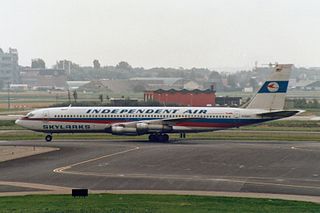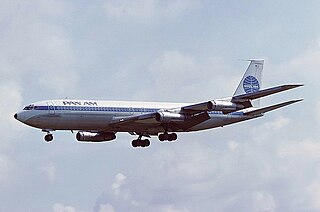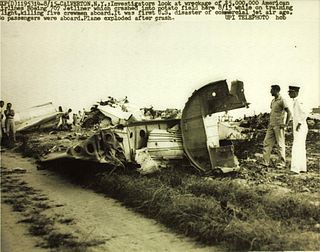
V. C. Bird International Airport is an international airport located on the island of Antigua, 8 km (5.0 mi) northeast of St. John's, the capital of Antigua and Barbuda.

Pan Am Flight 759 was a regularly scheduled domestic passenger flight from Miami to San Diego, with en route stops in New Orleans and Las Vegas. On July 9, 1982, the Boeing 727 flying this route crashed in the New Orleans suburb of Kenner after being forced down by a microburst shortly after takeoff. All 145 on board, as well as eight people on the ground, were killed.

On 8 February 1989, Independent Air Flight 1851, a Boeing 707 on an American charter flight from Bergamo, Italy, to Punta Cana, Dominican Republic, struck Pico Alto while on approach to Santa Maria Airport in the Azores for a scheduled stopover. The aircraft was destroyed, with the loss of all 144 people on board, resulting in the deadliest plane crash in Portugal's history. All of the passengers on board were Italian and all of the crew were Americans. The crash is also known as "The disaster of the Azores".

Pan Am Flight 816 was an international flight from Auckland, New Zealand, to San Francisco, California, via Tahiti, French Polynesia, and Los Angeles, California. It was operated by a Pan Am Boeing 707-321B bearing the registration N417PA and named Clipper Winged Racer. On July 22, 1973, at 10:06 P.M. local time, the Boeing 707 took off from Faa'a International Airport in Papeete. Thirty seconds after takeoff, the airliner, carrying 79 passengers and crew, crashed into the sea. All occupants except 1 passenger were killed.

Pan Am Flight 806 was an international scheduled flight from Auckland, New Zealand, to Los Angeles, California, with intermediate stops at Pago Pago, American Samoa and Honolulu, Hawaii. On January 30, 1974, the Boeing 707 Clipper Radiant crashed on approach to Pago Pago International Airport, killing 87 passengers and ten crew members.

Pan Am Flight 812 (PA812), operated by a Pan American World Airways Boeing 707-321B registered N446PA and named Clipper Climax, was a scheduled international flight from Hong Kong to Los Angeles, California, with intermediate stops at Denpasar, Sydney, Nadi, and Honolulu. The airplane briefly appeared in the Willy Wonka and the Chocolate Factory movie in 1971. On April 22, 1974, it crashed into rough mountainous terrain while preparing for a runway 09 approach to Denpasar after a 4-hour 20-minute flight from Hong Kong. All 107 people on board perished. The location of the accident was about 42.5 nautical miles northwest of Ngurah Rai International Airport. Until the 1991 Jakarta Indonesian Air Force C-130 crash, it was the deadliest aviation accident to happen on Indonesian soil.

Pan Am Flight 217 was a Boeing 707 that crashed near Caracas, Venezuela while on a flight from New York City, USA on December 12, 1968. Though pilot error was to blame, the National Transportation Safety Board concluded the probable cause was undetermined. There were no survivors.

Pan Am Flight 526A, a Douglas DC-4, took off from San Juan-Isla Grande Airport, Puerto Rico, at 12:11 PM AST on April 11, 1952 on a flight to Idlewild International Airport, New York City with 64 passengers and five crew members on board. Due to inadequate maintenance, engine no. 3 failed after takeoff, followed shortly by engine no. 4. Nine minutes after takeoff, the aircraft ditched in rough seas 11.3 miles NW of San Juan Airport, broke apart and sank after three minutes. Panicking passengers refused to leave the sinking wreck. 52 passengers were killed, and 17 passengers and crew members were rescued by the USCG. After this accident it was recommended to implement pre-flight safety demonstrations for over-water flights.

American Airlines Flight 514 was a training flight from Idlewild International Airport, to the Grumman Aircraft Corp. airfield. On the afternoon of August 15, 1959, the Boeing 707 operating the flight crashed near the Calverton airport, killing all five crew members aboard. This was the first accident to involve a Boeing 707, which had only gone into service in October of the previous year, and the first of three accidents involving American's 707s in the New York area within three years, followed by Flight 1502 and Flight 1.

Pan Am Flight 843 was a scheduled domestic commercial flight from San Francisco, California, to Honolulu, Hawaii. On Monday, June 28, 1965, Clipper Friendship, the Boeing 707-321B operating this route, experienced an uncontained engine failure shortly after take-off, but was successfully able to make an emergency landing at nearby Travis Air Force Base. The engine failure had been caused by faulty installation and maintenance procedures. The accident was filmed by a passenger.

Varig Flight 810 was a scheduled international passenger flight from Rio de Janeiro to Los Angeles with stopovers in Lima, Bogotá, Panama City, and Mexico City. On 27 November 1962 the Boeing 707-441 operating the route crashed into a mountain on approach to Lima, killing all 97 passengers and crew. At the time it was the deadliest aviation accident in Peru until being surpassed by LANSA Flight 502 in 1971 and later Faucett Perú Flight 251 in 1996.










